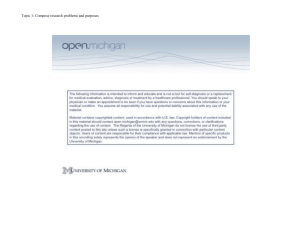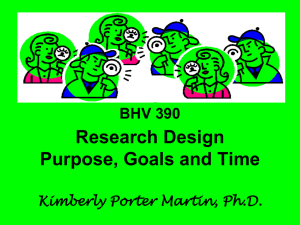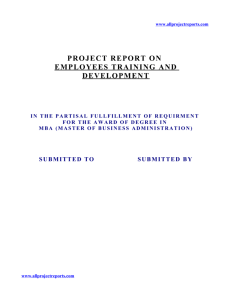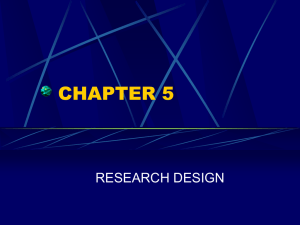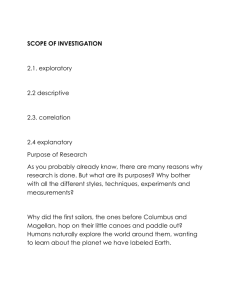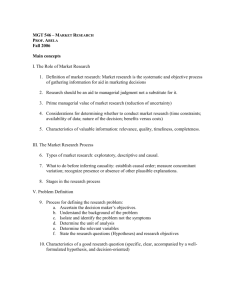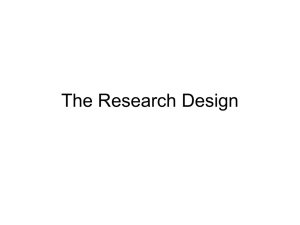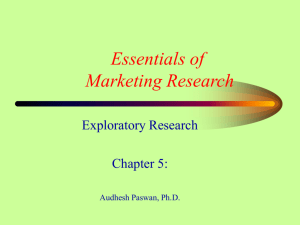Market Research Notes
advertisement
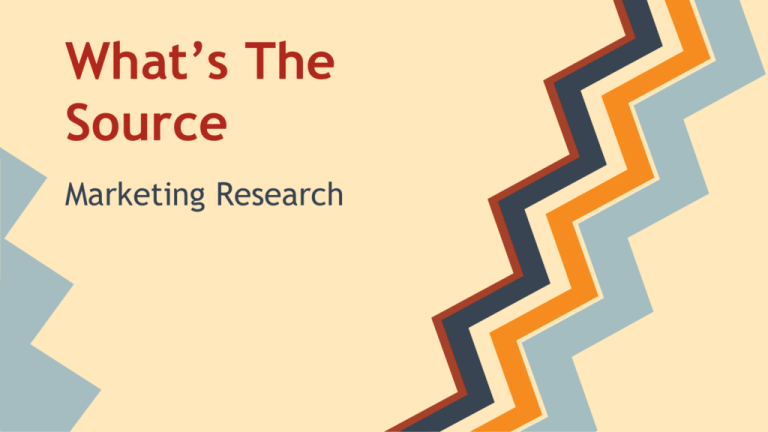
What’s The Source Marketing Research Marketing Research Is the systematic gathering, recording, and analyzing of data about a specific issue, situation, or concern. Use the packet to write down the five reason /purpose for marketing research Data that already exists in the organizations on information system Sales invoices Cash register receipts Sales reports Expense accounts Customer records Warranty cards Comment cards Profit and loss statements Collects data specifically for that business to make improvements Surveys Mail survey Telephone survey Face-to-face interviews (inperson survey) Internet survey Observation Focus group Informal interview Experiments Two types of primary Data Qualitative Feelings, thoughts, and experiences influence this data. Use questionnaires, focus groups, informal interview, or observation Flexible and unstructured • Quantitative Based on facts and numerical data Use surveys, field tests, and experiments Highly structured Market Research Qualitative data Subjective data based on thoughts, feelings, opinions, and experiences Review background info Clarify research questions Create hypotheses Methods: Questionnaires Focus groups Informal interviews Simple observation Performed using short time frames & small samples. Opened ended and unstructured questions are asked May not represent the Market Research Quantitative data Are objective based on statistics and fact and represented by numbers Gather this data to Make accurate predictions Develop more insight into relations between market factors Test and validate hypotheses. Methods Surveys Field tests Experiment Results are highly structured Takes longer period of time to complete than qualitative Uses large samples to represent the entire Better by Design Unit: Marketing Information Management Research Design Purpose for Conducting Research Hypotheses To explain something To predict something To monitor something To discover something To test hypotheses Marketers use this research to test their hypotheses and see if they are correct. Decisions are made based on the problem at hand. An Educated Guess is called a hypothesis. They are also called an “if – then” statements If I exercise everyday for the next six weeks, I will lose five pounds.” Grand Design= Research Design The master plan for conducting the marketing research is called Research Design Exploratory Research Descriptive Research Casual Research Common uses To learn more To take a snapshot of some aspect of the a market Test if then hypothesis Types of data Qualitative research Quantitative Quantitative Methods used Flexible, unstructured Structured Highly structured Examples Focus group, pilot study Survey, case study Test marketing , clinical trial Research Process Allie, Nash, Jake Stage One: Problem Formulation ❖ The heart of the research process. ❖ Translating the management problem into a research problem. ❖ Gives the type of information needed to help solve the problem. ❖ End result - a statement of the management problem that is meaningful and points to alternative solutions How to Formulate the Research Problem 1. Specify the Research Objectives: Objectives can guide the researcher in developing good research and can help the client evaluate the completed project. 2. The Environment or Context of the Problem: The researcher must be aware of, and assist in, the ID of objectives, courses of action, and the environmental variables because they affect the design of the research investigation. Cont... 3. The Nature of the Problem: Understanding the nature of the problem helps a researcher ensure that the right problem is being investigated and that a marketing plan can be developed to solve the problem. Cont... 4. Alternative Courses of Action: Once the nature of the problem has been agreed on. the course of action must be specified, which includes: ❖ determining which variables affect the solution to the problem ❖ determining the degree to which each variable can be controlled ❖ determining the functional relationships between the variables and which variables are critical to the solution of the problem Cont... 5. The Consequences of Alternative Courses of Action: Anticipate and communicate the possible outcomes of various courses of action that may result from following the research. 6. Degrees of Uncertainty: The decision-making manager can assign various “likelihoods of occurrence” to the various possible outcomes of specific courses of action. Stage Two: Method of Inquiry ❖ Market researchers use scientific methods to investigate. it makes great use of existing knowledge both as a starting point for investigating and checking results. Stage Three: Research Method ❖ There is two methods that can answer any research question: experimental research, and non-experimental research. ❖ Experimental: Controls variables ❖ Non-Experimental: No intervention Stage Four: Research Design ❖ It is the specific methods and procedures for acquiring the information needed. ❖ It’s a plan for studying and collecting the data. Stage Five: Data Collection Techniques ❖ A number of techniques available for collecting data can be used. Some are unique to a method of inquiry. ❖ The two general types of collection uses either communication or observation. ❖ Communication: Asking customers questions ❖ Observation: Observing customers as they shop Stage Six: Sample Design This stage involves picking the sample group that your research project will be used on. No research project uses an entire population. It involves, where it will be, the process of selection, and the size of the sample. Stage Seven: Data Collection This stage consists of collecting all the data that you gather from the research group in your project. Research collection is costly and may require specialized forms of data collection. Stage Eight: Analysis & Interpretation After the data has been collected from the specific groups, it has to be analyzed to see what it means and interpreted to see how it can be applied to your business. Stage Nine: Research Report All of the data and its analysis has to be put into a report for other businesses and the higher-ups of your own business can see and it can be used as evidence for your results. Exploratory Studies Evan Figert, Madison McMillin, Madi Johnson, Bailey Baxter Secondary Sources ● Research that helps a business define its issue, situation, or concert is called exploratory research. Exploratory Research Focus Groups are used with this type of reserch . Usually consist of 8 to 12 people Selected based on common background The moderator works with the client to develop a general discussion outline Pilot study( test feasibility ) Informal dicussions Interviewing Not inteded to help marketers make a final conclusion Purposes of exploratory ● Often the first in a series of projects ● Major purpose is to identify problems ● Often used as an introductory phase of a larger study, and the results are used to bring focus to the larger study. ● Three steps of exploratory studies: - a search of secondary information sources - interviews with persons knowledgeable about the subject area - the examination of analogous situations Exploratory Design ● Deals with exploring into the phenomenon. ● Used in cases when the problem must be defined more precisely, and to gain additional insights before an approach can be developed. ● It is not used most times to generate a course of action for decision making. Information is loosely defined. ● Focuses on collecting either secondary or primary data using unstructured format or informal procedures to interpret them. Descriptive Design By: Briana Key, Brittany Boyer, Chermaine Howard Descriptive Design ~Typically concerned with determining the frequency with which an event occurs or the relationship between two variables. ~This type of design is typically purpose is to compares the relationship between two variables. ~To make predictions and customer behavior. ~To describe characteristics of a certain groups. ~Must collect data for a definite purpose. ~In comparison to exploratory design, descriptive design requires a clear specification of the who,what,when,where,why,how of the research. ● Sometimes called statistical research ● Used for: 1. 1.Taking a picture of a certain aspect of the market ● Zero in on a certain feature of the market ● 2. Determine the porportion of people that behave a certain way. ● 3. make specific predictions. ● Descriptive information provides a basis for the solution of marketing problems ● Results of Descriptive are quantitative and measurable and presented in charts and graphs. More….. ★ Often called observational designs by some researches ★ 4 descriptive studies★ ★ ★ ★ ★ ★ ★ ★ Comparison of functional features Demographics characteristics of the audience Number and location of retailers Identifying competitor’s prices Indepth surveys & carefully structrued questions Case studies Studying of ecnomic or technial trends Observing and recording customer behavior in action Casual Research By: William Byard, Cousin Marty, Christian Williams Also called conclusive research Focuses on testing cause and effects theories. Used when business is extremely familiar with the research matter and have hypotheses. Use simulations to conduct experiments This means that when it comes to casual research, you can cater to the specific individual because of how lax the research is. Sequence of Events Since the research is casual, it must come in a certain order of events. Casual research is completed by conducting experiement or simulations. examples: clinial trials Simulated stosores Test marketing Absence of Other Factors Although this research leaves room for variation between the parties involved It is conducted after exploratory and descriptive have been compelted
